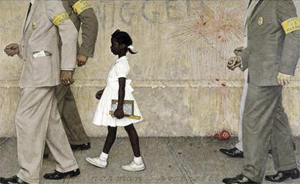ICONIC 1963 PAINTING ON LOAN FROM PERMANENT COLLECTION OF NORMAN ROCKWELL MUSEUM
Stockbridge, MA, July 5– Norman Rockwell Museum announces the loan of Norman Rockwell’s iconic painting “The Problem We All Live With,” part of its permanent collection, to The White House, where it will be exhibited through October 31. The loan was requested this year by President Barack Obama, in commemoration of the 50th anniversary of Ruby Bridges’ history-changing walk integrating the William Frantz Public School in New Orleans on November 14, 1960, that later inspired Rockwell’s bold illustration for the January 14, 1964 issue of “Look” magazine. “The Problem We All Live With” was the first painting purchased by Norman Rockwell Museum in 1975. The White House loan was made possible through the support of the Henry Luce Foundation.
“Norman Rockwell Museum is deeply honored that the White House has requested the loan of one of Rockwell’s most important paintings,” says Museum Director/CEO Laurie Norton Moffatt. “The painting has come to serve as an important symbol of civil rights, and Museum Trustee Ruby Bridges’ historic journey. We are enormously grateful for the support of the Luce Foundation, that made the loan possible.”
Ruby Bridges’ historic walk took place six years after the 1954 United States Supreme Court Brown v. Board of Education ruling declared that state laws establishing separate public schools for black and white students were unconstitutional, and represented a definite victory for the American Civil Rights Movement. Among those Americans to take note of the event was artist Norman Rockwell, a longtime supporter of the goals of equality and tolerance. In his early career, editorial policies governed the placement of minorities in his illustrations (restricting them to service industry positions only), however in 1963 Rockwell confronted the issue of prejudice head-on with one of his most powerful paintings–“The Problem We All Live With.” Inspired by the story of Ruby Bridges and school integration, the image featured a young African-American girl being escorted to school amidst signs of protest and fearful ignorance. The painting ushered in a new era in Rockwell’s career, and remains an important national symbol of the struggle for racial equality.
“I was about 18 or 19 years old the first time that I actually saw it,” says Ruby Bridges Hall, who now serves on the board of Norman Rockwell Museum. “It confirmed what I had been thinking all along–that this was very important and you did this, and it should be talked about… At that point in time that’s what the country was going through, and here was a man who had been doing lots of work–painting family images–and all of the sudden decided this is what I am going to do… it’s wrong and I’m going to say that it’s wrong.”
The illustration appeared in the January 14, 1964 issue of “Look” magazine, and earned Rockwell letters of both praise and criticism from readers unused to such direct social commentary from the illustrator. Rockwell would revisit the theme of civil rights in several other illustrations from the period, and in 1970 received the Million Dollar Club Award from The National Association for the Advancement of Colored People (NAACP), for having contributed $1000 to the organization.
Ms. Bridges Hall, who founded The Ruby Bridges Foundation in 1999 to promote the values of tolerance, respect, and appreciation of all differences, commends Rockwell for having “enough courage to step up to the plate and say I’m going to make a statement, and he did it in a very powerful way.” Learn more about the Ruby Bridges Foundation at https://rubybridgesasingh.weebly.com/ruby-bridges-foundation.html.



